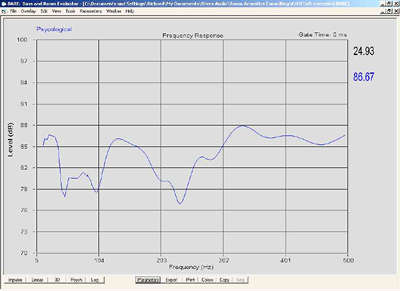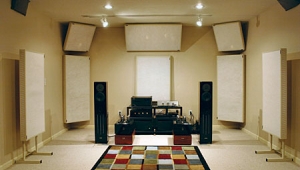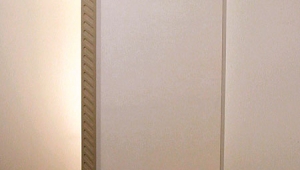| Columns Retired Columns & Blogs |
Rives Audio PARC 3-Band Parametric Equalizer Page 3
From these measurements, Richard Bird suggested the following corrections:
| Channel | Frequency (Hz) | Q | Attenuation (dB) |
| L1 | 32.7 | 1.9 | 10.0 |
| L2 | 134 | 1.1 | 5.0 |
| L3 | 350 | 5 | 1.4 |
| R1 | 35.3 | 1.4 | 4.0 |
| R2 | 84.5 | 3.0 | 3.0 |
| R3 | 211 | 4.4 | 3.8 |
These were transferred to the PARC and the measurements repeated. The results (figs.2 and 4), revealing a reduction in irregularity and overall lowering of bass levels compared with the midrange. If the frequency scale were logarithmic, the overall smoothing would be more visually apparent. Note that the measured acoustical attenuations are all less than the calculated attenuations set in the PARC. I ascribe this discrepancy to the energy storage of the room modes (remember, they're still there), and suspect that John Atkinson will find that the PARC's filters measure pretty close to spec.

Fig.2 Rives PARC, corrected response of left channel from BARE. Note reduction in peaks and overall lowering of average bass levels.

Fig.4 Rives PARC, corrected response of right channel from BARE. Note reduction in lower three peaks.
PARC Listening
With the PARC set to Bypass, its audible effect was vanishingly subtle. In either the recommended setup (between preamp and power amp) or the alternative setup (in the tape monitor loop), the difference between Bypass and straight-through with filters nulled was insignificant. In its active role, with filters set below 400Hz, the PARC was completely transparent in both the critical midrange and the revealing treble range. The high frequencies did seem a little brighter, in comparison with removing the PARC from the signal path, but this was probably the psychoacoustic concomitant of the improved, unmuddied bass. Way down, in the room-mode-vulnerable lower midrange and bass, the PARC was changing the sound, as was intended.
There were two ways to hear what the PARC did. First, I chose the deep male voices of Thomas Hampson and David Johansen (or any male WQXR announcer), and listened while switching the EQ in and out. With PARC EQ, the voice was always firmer, better defined harmonically and spatially, and easier to distinguish musically. Considering the corrections in the 200-350Hz range, this is not surprising.
To hear what the PARC did further down, I listened to Ray Brown's double bass on his classic Soular Energy album. The PARC maintained the powerful plucking with equal force and shape, despite attenuating rather than boosting any of the relevant frequencies. By fiddling with the controls, I found that the upper-bass corrections had a greater ameliorative effect than the lowest ones, even though the instrumental fundamentals were quite a bit lower. This is probably due to the ear's sensitivity dropping off at the very lowest frequencies and to the bass fiddle's harmonic richness.
One curious observation with Soular Energy was that the PARC corrections were both more effective and more appreciated with the analog signals from the DVD-Audio (HiRes HRM 2011) via the Meridian 800/861 DVD-Audio player, or the SACD (Groove Note GRV 1015-3) via the Sony XA-777ES SACD player, than from the LP (Pure Audiophile PA-002(2)). Pure Audiophile's blue vinyl discs are simply spectacular, with potent, taut bass at relatively higher levels than from the digital media, with or without PARC. One might chalk that up to the fact that the PARC correction was not customized to my particular combination of turntable, tonearm, cartridge, and phono stage, which, I'd venture, is not completely linear. With other, lesser LPs, the PARC wrought the same transformations as it had with the digital sources.
- Log in or register to post comments































